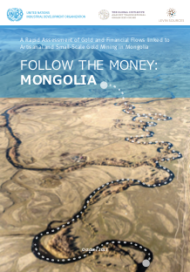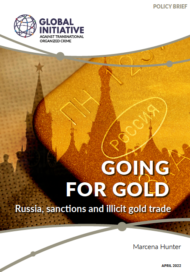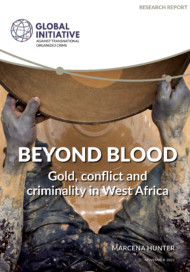Posted on 21 Sep 2016
A definition of illicit financial flows, what’s missing from the data – and the role of the GIFF Project across the entire supply chain
Illicit financial flows (IFFs) are an obstacle to achieving development aims and one of the greatest contemporary global challenges. However, in understanding, and thus combatting IFFs, it is important to recognise it is a complex subject with many grey areas and nuance, making it difficult to apply terms to a broad scope of activities across a large geographic area. While IFFs are increasingly discussed, limited understanding, concrete data and even agreement on definitions hamper the debate.The Global Initiative against Transnational Organized Crime has authored a report that will be published by the OECD later this year examining IFFs in West Africa. I wrote a chapter examining IFFs linked to the artisanal and small-scale gold mining (ASGM) sector in Ghana and Liberia. The report underlined that whilst some activities are illegal, such as drug trafficking, others are unregulated or fall into a grey area.
This is the case with the gold sector. We must continue to study, better understand, and raise awareness of the relationship between the ASGM sector and IFFs. This is what the GIFF project seeks to achieve: illuminate how criminal groups exploit the gold sector, and increase stakeholder capacity to effectively implement formalisation efforts.
Estelle Levin-Nally reminds us that ASGM is a business, a reality that organised crime has not forgotten. The low-risk and high-profit nature of ASM is a magnet for illegality. It is economic principles, cost-benefit analysis, in its most basic form.
With regulations tightening on formal financial institutions, and the continuing war on drugs, other forms of criminal activity and money laundering are increasingly higher risk. ASGM, with the potential to generate huge profits and weak regulatory enforcement, thus represents an alluring sector for exploitation by organised crime.
In exploiting the ASGM sector, organised crime also exploits the most vulnerable in society: miners. We must recognise the miners as victims, and focus on the illicit financial flows and not the illicit mining activities.
Defining Illicit Financial Flows
The surrounding lexicon on IFFs is not well defined, and fails to capture the extensive and multi-dimensional harms that result from IFFs and criminal economies. The physical, social, environmental, and governmental impacts aren’t fully captured by exclusively focusing on financial flows or capital flight.
To ensure a broader application and understanding, we define IFFs as money illegally earned, transferred and used. This is especially important in the gold sector, because gold is unique in that it has a monetary value all of its own. It’s not just about currency flows: to measure IFFs we must look at currency, gold and even goods.
It’s important to recognise that while IFFs do take on many forms, they are often closely associated with criminal activity, groups, and networks. Furthermore, both the gold sector and IFFs can be cyclical in nature. Research, in its early stages, is revealing that flows are being invested back into the gold sector.
This must be accounted for when tracking IFFs. Ultimately, the biggest financial beneficiaries of this must be ascertained: those are the actors with the greatest motivation to keep the sector informal, and thus to thwart formalisation efforts. By tracking IFFs, we hope to better understand these actors, who can be very well hidden – or hidden in plain sight.
Addressing the data gap
A significant challenge to understanding and responding to IFFs are profound knowledge gaps. Challenges include measuring the direction and scale of IFFs, which in turn raises the problem of differences in methodology used by different actors. There are data sets missing, particularly those which enable comparisons between countries.
Seizure data, traditionally used for drugs, is not always helpful for gold since it acts more as a measure of law enforcement capacity, than of how much gold or other illicit goods are moving. There are many challenges ahead, but the need for data is paramount.
The first step is to untangle the sector, in order to approximate what is happening with the flows. This will mean breaking down the flows into the smallest parts possible, trying to identify each individual transaction within a flow.
Each of these transactions must be further investigated, identifying: is this as it seems? Is there something else happening? What tangential transactions are also happening? Often that transaction is not one in and of itself; other transactions and relationships are associated.
A view of the entire value chain
The multi-dimensional nature of the sector and the flows – noting the profound differences between downstream and upstream activity – creates a need for a number of different tools. To inform these tools, one must undertake mine site visits, key informant interviews, and interviews with individuals engaged within this supply chain, as well as analysing financial trade data, transactions all along the supply chain, and ensuring forensic accounting and desk research.
Upstream investigations will focus on pre-financing and production. It’s important to build an understanding of not only how much gold is being produced, but what percentage of the gold price actors are receiving, and what percentage of this flow is staying and being reinvested back into the local economy. There is the potential for this to support formalisation efforts, and inform future policy.
Moving down the supply chain, the situation is increasingly convoluted. A complex web of buyers and exporters often handle gold before it reaches refineries in transit and destination countries. This phase of IFFs presents a particular challenge when tracking a flow, and will require a multi-faceted methodology to untangle and better understand the scale and direction of IFFs.
Next in the supply chain, exporters and regional trading hubs become important. Gold isn’t necessarily exported from the country in which it is mined. In many regions where ASGM takes place porous borders enable actors to easily move undeclared gold from one country to another. At this point, criminal activity is thought to become more sophisticated, involving shell companies and the use of tax havens.
Research will need to be undertaken to ascertain information such as the beneficial ownership of companies exporting gold and other export businesses these individuals are involved in. It is important to examine import, export, and seizure figures for discrepancies. Are neighbouring countries reporting higher exports than they should when triangulated with production figures?
Consumption figures can be revealing as well. At point, China and India are the two largest consumers of gold in the world – so much so, they consume more gold than that which has been legally produced. Do we understand where all this gold is coming from?
By looking at the entire supply chain and then seeing how this money is being recycled back into the flow, we are better able to understand who is financially benefitting, who is perpetuating these flows, and where the pressure points are for intervention.
Author: Marcena Hunter is a Senior Research Analyst at the Global Initiative against Transnational Organised Crime, and Project Manager for the GIFF project.
This blog is part of the series Follow The Money: How to Formalise the Gold Sector. In May 2016, The GIFF Project hosted an International Symposium at the OECD-ICGLR-UN GoE Forum on Responsible Mineral Supply Chains in Paris, France. The Symposium featured presentations by some of the world’s leading lights on illicit financial flows as impediments to artisanal and small-scale gold mining formalisation. The Follow the Money series features blogs derived directly from the speakers’ presentations and interviews.
The GIFF Project is a collaboration of The Global Initiative Against Transnational Organized Crime and Estelle Levin Ltd. with generous funding from The Deutsche Gesellschaft für Internationale Zusammenarbeit (GIZ). Please find the full International Symposium Report, here.



